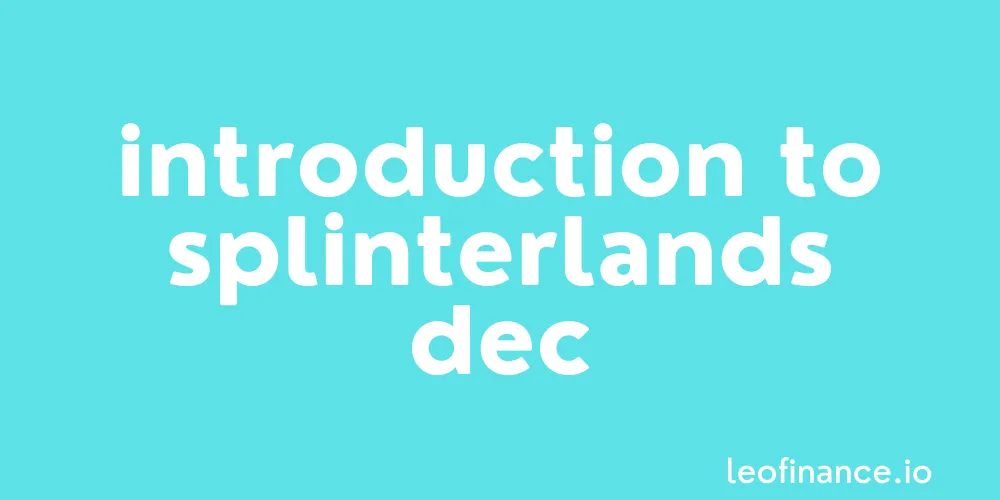
An introduction to Splinterlands DEC, the in-game currency of the popular Hive blockchain based NFT trading card game.
Splinterlands DEC, otherwise known as Dark Energy Crystals, is the in-game currency of the NFT trading card game built on the Hive blockchain.
Originally created as a Hive second-layer token on the Hive-Engine platform, Splinterlands DEC can now easily be traded on numerous decentralised exchanges on both Ethereum and BSC.

Our Splinterlands DEC guide will show you that this particular cryptocurrency is not only the lifeblood of the game, but a play to earn gamer’s ticket to making money.
Nothing shows that the age of abundance is truly upon us like DEC.
Introduction to Splinterlands DEC
An introduction to the Splinterlands game, DEC, SPT and SPS.
Before we get into the meat of this guide, let’s make a clear distinction between Splinterlands the game, the in-game currency of Dark Energy Crystals (DEC) and any other Splinterlands associated cryptocurrencies.
To kick things off, let’s walk through them one by one, below.
The Splinterlands game
Splinterlands is an NFT trading card game built on the Hive blockchain.
It is a digital trading card game similar to say Magic the Gathering, except each player retains full ownership of their cards and other in-game assets such as DEC.
This is possible because each Splinterlands card is actually a non-fungible token (NFT), with all supply and ownership details recorded on the immutable Hive blockchain.
Using their cards, players are able to first use them within the game for:
- Battling
- Collecting
- Combining
- Burning for DEC
But due to the fact that players retain full ownership of their NFT assets, you can then also sell them on the open market whenever you please.
No longer are players tied down by greedy video game studios who create yearly versions of games that renders all in-game assets on the old game worthless.
Blockchain-based, play to earn gaming has arrived and Splinterlands is leading the charge for players and investors alike.
For a full rundown of the advantages that the Hive blockchain has over other platforms, check out our detailed Hive crypto guide.
Dark Energy Crystals (DEC)
Dark Energy Crystals (DEC) are the in-game currency of the Splinterlands game.
The NFT ownership aspect of the game means that there is an entire Splinterlands associated economy wrapped around it.
All powered by the DEC token.
Dark Energy Crystals (DEC) truly are the lifeblood of the game, giving players an opportunity to make real money playing Splinterlands.
First of all, Dark Energy Crystals (DEC) is earned by players of the game, every time you win a ranked battle.
Being NFTs, each Splinterlands card also has a DEC burn value assigned to it.
It allows players to choose to sell their cards on the open market as NFT assets, or immediately burn them for their assigned DEC value.
This value is based on a number of factors including its foil, set, rarity and number of BCX.
Players are then able to quickly and easily trade their DEC for USD, BTC or any other cryptocurrency of their choice using decentralised exchanges on Ethereum, BSC or Hive.
Making Splinterlands DEC even more exciting, has been the recent price explosion that we can see on the CoinGecko chart below:

If an explosion in price like that doesn’t get you excited about DEC, I’m not sure what will.
Splintertalk (SPT)
Splintertalk (SPT) is a completely separate token from DEC.
SPT is a Hive second-layer token rewarded for blogging about Splinterlands exclusively on the Splintertalk platform.
It can be staked to give you influence on the Splintertalk platform and then used to distribute the rewards pool via upvotes using the same system as HIVE.
All SPT rewards are split 50/50 between the author and curators who have voted on the content, before being paid out entirely in liquid SPT tokens.
While this token is independent of DEC and not actually used within the Splinterlands game itself, it has been given more meaning now that SPT rewards count towards Splintershards (SPS) airdrop points.
Not to mention the team’s future plans for the SPT token to fuel an entire Splinterlands side economy featuring an NFT marketplace for game-related content.
All of a sudden, this has made what was once seen as a useless blogging token, become an extremely valuable supplement to the Splinterlands DEC token.
SplinterShards (SPS)
SplinterShards (SPS) is another related, but still completely different token from DEC.
SPS is the brand new governance token that will be integrated into the Splinterlands game.
Once this has been achieved, its goal is to allow those who hold and stake the token to have an increased level of decision making.
SPS holders will have a level of control over the game and how the player base interacts with the dApp.
Every gamer with a stake in the Splinterlands ecosystem will receive a daily SPS reward over a 365 day period.
All in-game assets, including Splinterlands DEC held in a range of on and off-platform wallets, determine how many SPS airdrop points you can claim per day.
While there is still an element of the unknown surrounding the SPS token, it’s certainly an exciting prospect that DEC investors need to take notice of.
From here on, our guide to Splinterlands DEC will dive into earning and maximising your DEC.
Let’s go!
Best of probabilities to you.
Direct from the desk of Dane Williams.
Why not leave a comment and share your thoughts on Splinterlands DEC within the comments section below? All comments that add something to the discussion will be upvoted.
This Splinterlands DEC blog is exclusive to leofinance.io.
